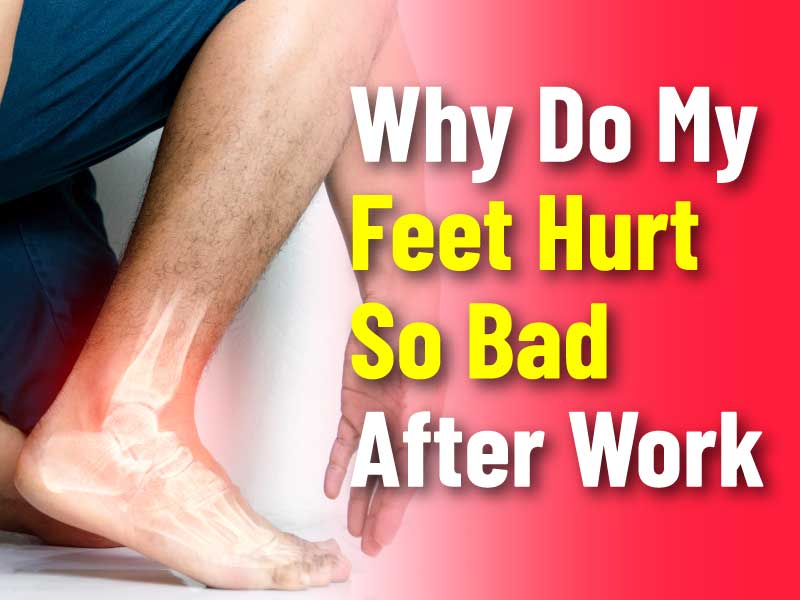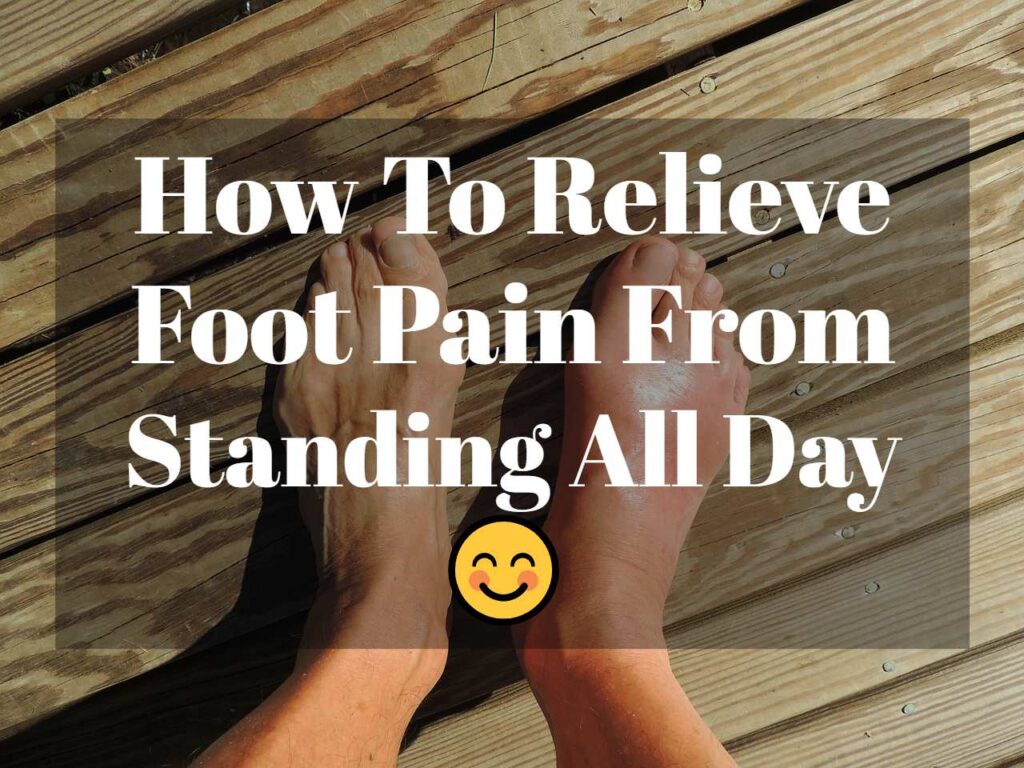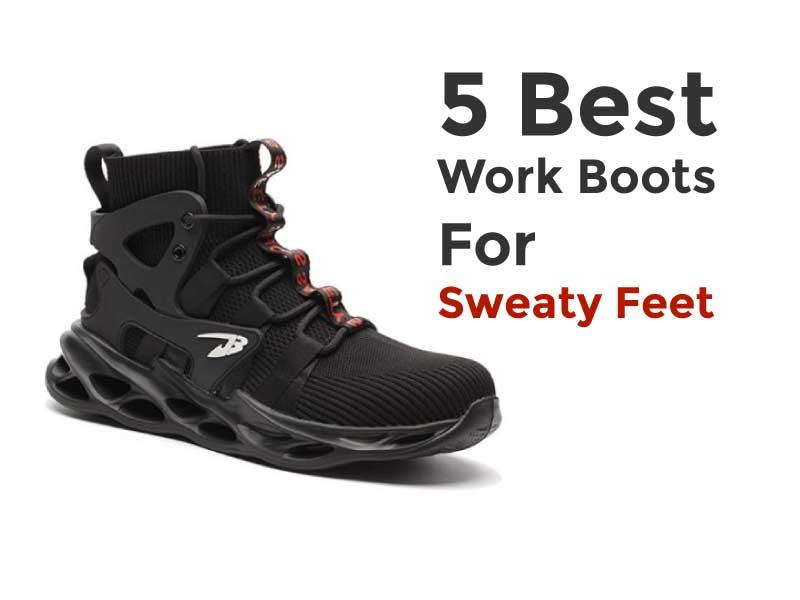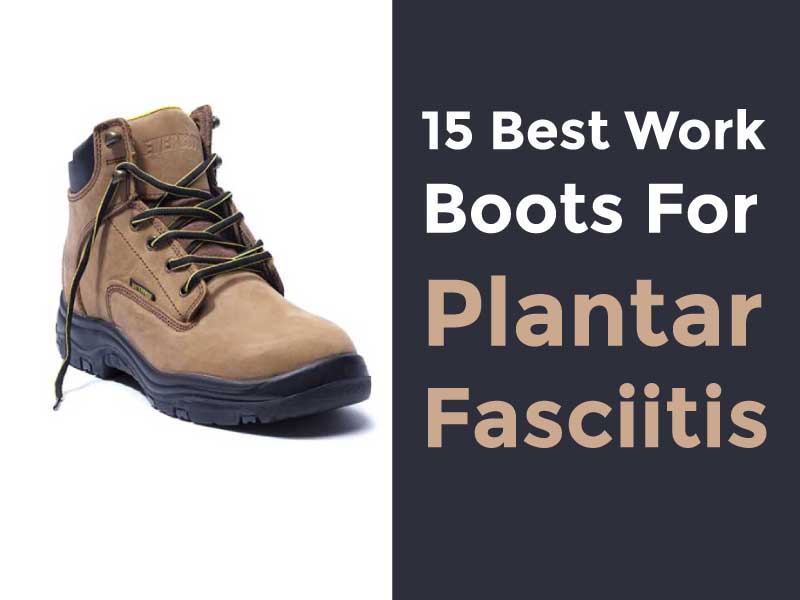Our leg muscles are the ones that constantly work almost throughout the day. Even when we are standing, the muscles in our legs and feet keep on working as they help us stand. Because of that, sore legs and feet is a common problem that thousands of people face daily. While few people worry and get them checked, neglecting your sore feet may cause many complications in the long run.
Our legs and feet house one of the strongest muscles in our entire body, and they can go through a lot of stress. As human beings, we walk almost 160,000 km in our entire lifetimes –that’s four times circling the earth at the equator. But like most, we don’t take them under consideration until they start to feel stressed and hurt.
Like walking, running, and all kinds of activities, standing for long hours may hurt the feet and jeopardize their health until we take good care of them. We will learn what hurts our feet and how to take care of them.
Contents
The reasons our feet hurt: standing long hours
When you keep standing for a long time, it affects the blood circulation in your feet. As the feet are not moving, these are the two most common problems people face.
Swelling of feet and legs
When you are standing still, the blood has no problem reaching down to your legs and feet, but it becomes difficult to get back up as there is no feet movement. The blood flow works against the gravity here and can’t function properly. This causes the blood to pool in the veins of your legs and feet, and that makes the feet swell and turn red. That also increases the blood pressure in those areas. In time, it starts to cause discomfort and eventually pain.
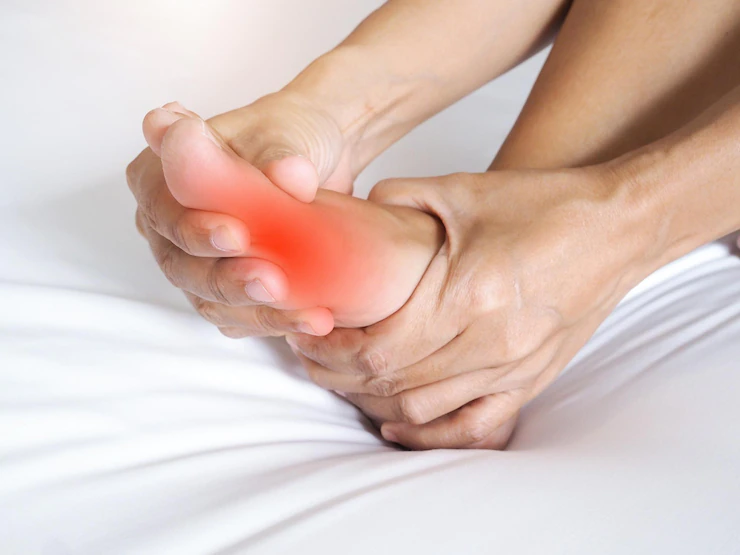
Leg and foot pain
Aside from swelling due to blood pooling in your feet, long hours of standing also puts a lot of pressure on the muscles, bones, tendons, and joints. From that, lactic acid builds up in those areas and can make your feet swell. Too much pressure on the bones and joints causes discomfort, fatigue, and cramps.
These two situations can lead to many medical conditions. The people who work in sales and other professions where they need to stand throughout their entire shifts suffer the most. Fortunately, there are a few tricks and tips to help you release the tension and relax, taking the pressure off of your feet.
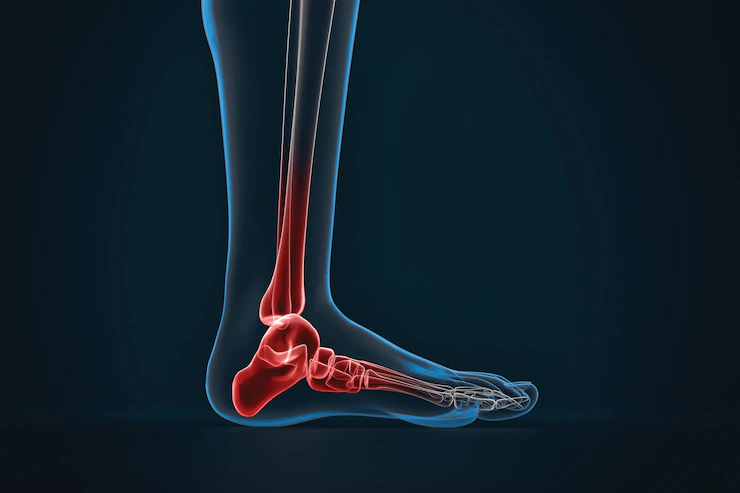
Identifying The Forms Of Foot Pain After Work And Their Sources
The Basics: What Is Foot Pain After Work
Foot pain after work is a common problem. It is a discomfort or pain felt in the feet after standing, sitting, or walking for long periods. The pain can be mild or severe and can affect people of all ages.
Foot Pain After Standing Or Walking For Long Periods
Standing or walking for long periods can cause foot pain after work. Some common causes of this type of pain include:
- Poor posture
- Overuse of muscles and joints
- Flat feet
- High arches
- Plantar fasciitis
Foot Pain After Wearing High Heels
Wearing high heels for extended periods can cause foot pain after work. High heels can place excessive pressure on the ball of the foot, causing pain and discomfort. Some common causes of this type of pain include:
- Morton’s neuroma
- Calluses
- Corns
- Blisters
- Achilles tendinitis
Foot Pain From Overexertion
Overexertion can cause foot pain after work. Some common causes of this type of pain include:
- Stress fractures
- Sprains and strains
- Torn ligaments
- Tendinitis
- Shin splints
Foot Pain Due To Ill-Fitting Shoes
Ill-fitting shoes can cause foot pain after work. Shoes that are too tight, too loose, or do not provide proper support can cause foot pain. Some common causes of this type of pain include:
- Bunions
- Ingrown toenails
- Hammertoes
- Heel spurs
- Metatarsalgia
Impact Of Previous Injuries On Foot Pain
Previous injuries can cause foot pain after work. Injuries that have not properly healed can cause chronic pain and discomfort. Some common causes of this type of pain include:
- Fractures
- Sprains
- Strains
- Dislocations
- Ligament tears
Foot pain after work can be caused by a variety of factors. Identifying the source of the pain is crucial in finding the right treatment. If you experience regular foot pain after work, it is important to consult a healthcare professional.
Unraveling The Complexities Of Foot Anatomy
What could be the reason or cause of the severe foot pain after work? There is a reason for that, and it all comes down to the anatomy of your feet. The human feet comprise 26 bones, 33 joints, along with an intricate network of muscles, tendons, and nerves.
Understanding the complexities of foot anatomy is crucial in identifying the factors that lead to foot pain. Let’s take a closer look at the different elements of the feet that play a role in foot pain.
An Overview Of The Human Foot Anatomy
To understand why your feet hurt so much, you must know what is inside the feet. It is essential to know that each foot consists of three parts: the hindfoot, midfoot, and forefoot. The hindfoot comprises the heel bone (calcaneus) and ankle (talus).
On the other hand, the midfoot is responsible for the arch of the foot, and the forefoot consists of the toes, metatarsals, and phalanges. Understanding these foot structures will help you identify the problems in each of the specific areas and seek treatment accordingly.
The Function Of The Arch And Sole In Foot Pain
Commonly, many people experience pain in their arches and soles that can be due to various reasons such as injuries, plantar fasciitis, or even overuse. Our arch, consisting of rigid and flexible components helps absorb the body’s weight, distributes it evenly, and aids in shock absorption.
The sole aids in the process by providing cushioning to the arch, providing support to the foot’s structure, and overall balance. However, any damage, strain or an injury to these areas can result in excruciating foot pain.
Understanding The Purpose Of Toes In Bearing Weight
Another part of our feet that plays an essential role in bearing weight is our toes. The toes contain bones, joints, and muscles that help in gripping, lifting, and stabilizing our body. The toes must work correctly to maintain balance and support the body’s weight.
An injury to the toes or improper gait can lead to various foot problems, including pain and stability issues.
Role Of Tendons, Ligaments, And Muscles
The muscles, tendons, and ligaments present in the feet are responsible for our movement and stability. However, any strain, overuse, or stress can lead to pain and other foot conditions. The tendons connect muscles to bones, while ligaments hold bones together, providing overall support to the feet.
The calf muscles, peroneals, and extensors help move the foot. The plantar fascia, one of the foot’s critical structures, is a band of tissue that stretches from the heel to the toes and is responsible for running. Any injuries to these areas can lead to pain and mobility issues.
Blood Circulation And Nerve Function In Foot Pain
Apart from the structures mentioned above, proper blood circulation and nerve function are just as critical in keeping our feet healthy. The proper flow of blood helps bring oxygen, nutrients, and other essential elements to the feet. Any restrictions due to conditions such as peripheral artery disease can lead to serious foot problems.
The proper functioning of nerves is also essential in sending messages throughout the feet and the entire body. Damaged or pinched nerves can cause various foot problems such as numbness, tingling, and sharp pain.
Unraveling the complexities of foot anatomy is crucial to understanding why your feet hurt after work. Any damage to the feet’ structures can lead to excruciating pain and mobility issues. Seeking medical attention at the first signs of discomfort is vital to receive an accurate diagnosis and timely treatment.
Common Contributing Factors To Foot Pain After Work
Working long hours on your feet can cause a considerable amount of pain and discomfort. Here are the common contributing factors that can cause foot pain after work.
Age-Related Factors
As we age, our feet go through a lot of changes which can contribute to foot pain. Some of the factors that can cause foot pain in older adults include:
- Lack of cushioning in the feet
- Decreased circulation
- Decreased flexibility
- Loss of balance
Health Factors: Arthritis, Plantar Fasciitis, Gout, Etc.
Certain underlying health conditions can result in foot pain. Here are some of the health factors:
- Arthritis: Arthritis can cause inflammation in the joints, resulting in pain and stiffness in the feet.
- Plantar fasciitis: Plantar fasciitis is the inflammation of connective tissue that runs from your heel to your toes, resulting in intense heel pain.
- Gout: Gout is a type of arthritis that affects the feet, causing sudden and severe pain.
- Diabetes: Diabetes can lead to nerve damage, resulting in tingling, numbness, and pain in the feet.
The Difference Between Professional And Manual Labor
The type of job you have can also play a role in foot pain after work. Here are the differences between professional and manual labor:
- Professional labor: Jobs that involve sitting for prolonged periods, such as office jobs, can cause foot pain due to lack of movement and poor posture.
- Manual labor: Jobs that require standing or walking for an extended period, such as construction work, can result in foot pain due to stress on the feet and lower limbs.
The Significance Of Physical Activity And Exercise
Physical activity and exercise play a crucial role in maintaining foot health. Here is why physical activity and exercise are important:
- Helps to strengthen muscles and improve flexibility
- Increases circulation and reduces inflammation
- Helps to manage weight, reducing stress on the feet
Work Environment And Equipment
The work environment and equipment you use can also contribute to foot pain. Here are some factors to consider:
- Poorly fitting shoes: Tight or poorly fitting shoes can cause blisters, corns, and calluses, leading to foot pain.
- Hard surfaces: Walking or standing on hard surfaces for an extended time can cause stress on the feet and lower limbs.
- Uneven surfaces: Walking on uneven surfaces can cause trips and falls, leading to foot injuries.
Incorporating foot-strengthening exercises, proper footwear, and ergonomic workstations can help alleviate foot pain and discomfort after a long day at work. Remember, it’s essential to listen to your body and seek medical attention if the pain persists.
Things you can do to release the stress from your feet from standing all day:
The basic mantra is not letting your feet stay in the same position for a long time. Follow the tips below to take care of your feet.
Walk when you can
Walking is one of the most beneficial exercises for everyone. Try to walk around a little bit if you have that chance. Walking will release stress and help with blood circulation, also saving the muscles from cramps.
Massage your feet
Standing for too long causes inflammation in your feet. Massaging them will increase fresh blood flow in those affected areas and reduce inflammation. Moreover, it helps the plantar flexor muscle move freely and reduces any pain.
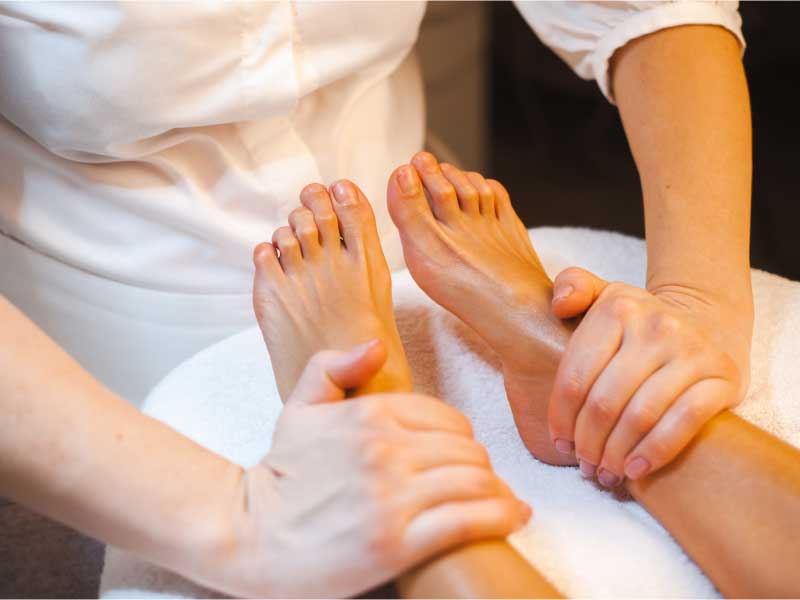
Elevate your feet if you can
As soon as you lift your feet, the pooled blood in your legs and feet starts to move upwards, and that normalizes the blood circulation. It also releases stress from the muscles and joints and helps them neutralize. It is best to keep your feet in that position for at least ten minutes.
Stretch your legs
This is also an excellent tip that helps to neutralize the pressure and fatigue in your feet and legs. Moreover, it helps with the blood flow and releases the tension off your legs.
Wear supportive shoes
Many work shoes come with increased feet and heel support to maximize comfort when you’re standing for long hours. Make sure the shoes are a bit rigid and provide room to move your toes. Bigger, more rigid boots provide better support in these situations.
The Essentiality Of Proper Footwear To Prevent Foot Pain
Working all day long on your feet can be exhausting, and the last thing you want to experience is excruciating foot pain. Unfortunately, this is a common problem caused by the wrong choice of footwear. Therefore, it is essential to know how to select proper shoes to prevent foot pain.
We will share insights on how to choose the right shoes based on your work type, how to determine the suitable shoe size, and the importance of arch and heel support in shoes. We will also talk about dansko footwear and their reviews and provide useful tips for breaking in new shoes.
Let’s dive in!
Choosing Footwear According To Work Type
The type of shoes you wear to work should be directly related to the type of job you have. It is essential to choose shoes that offer comfort, protection, and support based on your work type. Here are some tips to consider when choosing footwear based on your work type:
- For people who work in construction, factory workers, and warehouse employees, boots with steel-toe caps are most suitable. Safety should always be a top priority for these jobs.
- If you work in the healthcare industry or the foodservice sector, consider shoes made with materials that are easy to clean and resistant to stains and fluids.
- For people who work in offices or retail stores, shoes with low heels or flats are most suitable because they provide support and comfort throughout the working day.
How To Determine Suitable Shoe Size
Wearing shoes that don’t fit properly can lead to several foot problems, including blisters, bunions, and even back pain. Therefore, it is essential to know how to determine the right shoe size. Here are some tips to help you determine the suitable shoe size:
- Measure your feet regularly and, if possible, have them measured by a professional who can identify any abnormalities.
- Always try on shoes at the end of the day when your feet are at their largest.
- Leave a little bit of space between your toes and the front of the shoe. Your toes should not feel constricted.
- Walk around the store to get a feel for the shoes before purchasing.
The Importance Of Arch And Heel Support In Shoes
Wearing shoes with proper arch and heel support isn’t just about comfort; it can also prevent serious foot problems. Here are some benefits of wearing shoes with proper arch and heel support:
- Provides shock absorption and prevents heel pain.
- Reduces stress on the joints, muscles, and ligaments in your feet, which can help prevent injuries.
- Improves your overall posture, preventing back and hip pain.
‘Dansko’ Footwear And Their Reviews
Dansko shoes are popular among people who value comfort and support when it comes to footwear. These shoes are known for providing excellent arch support, cushioning, and comfort. Here are some pros and cons of dansko shoes:
Pros:
- Suitable for people who stand for long periods as they provide ample support and cushioning.
- Durable, with some people reporting that they have worn them for years.
- Available in a variety of styles, colors, and designs.
Cons:
- Some people report that they are heavy and take some time to break in.
- They are relatively expensive compared to other brands.
Tips For Breaking In New Shoes
New shoes tend to be stiff and uncomfortable when first worn. Here are some useful tips for breaking in new shoes:
- Wear the shoes for short periods, gradually increasing the time each day.
- Wear thick socks when trying to break in new shoes to provide extra cushioning.
- Use a shoe stretcher to stretch out specific areas of the shoe that may be causing discomfort.
Choosing the right footwear is essential to prevent foot pain. Always select shoes based on job type, determine the right shoe size, and choose footwear with proper arch and heel support. If you’re in the market for new shoes, consider dansko shoes, but remember to break them in slowly.
By following these tips, you’ll be on your way to happy, healthy feet!
Coping With And Preventing Foot Pain After Work
Have you ever experienced pain in your feet after work that makes you want to scream? You are not alone. Foot pain is a common problem amongst adults, especially those who spend extended periods standing or walking. Coping with and preventing foot pain after work can be challenging; however, there are several practical steps that you can take.
Stretching And Foot Exercises To Ease Foot Pain
Stretching and foot exercises are some of the most practical ways to manage foot pain after work. These exercises help reduce muscle tension, improve blood flow, and keep the feet flexible. Below are some useful stretching and foot exercises that you can try:
- Toe-curls: Sit on a chair with your feet flat on the ground, and try to curl your toes towards the ground. Hold each curl for at least five seconds.
- Heel raises: Stand with your feet shoulder-width apart, press your heels firmly on the ground, and lift your body weight onto your toes. Hold for five seconds, then lower your heels to the ground.
- Ankle rotations: Sit on a chair, extend one leg, and rotate your ankle ten times in each direction.
Home Remedies To Manage Foot Pain
Several home remedies can help manage foot pain after work. Here are some of the most effective:
- Epsom salt: Soak your feet in warm water with epsom salt for 15-20 minutes. Repeat the process two to three times per week.
- Vinegar: Add a cup of vinegar to some warm water, and soak your feet for 10-15 minutes. Rinse with clean water.
- Essential oils: Apply a few drops of essential oil such as peppermint oil or eucalyptus oil to your feet, and massage them gently.
The Use Of Heat And Ice To Soothe Sore Feet
Both heat and ice can help reduce foot pain after work. Heat therapy increases blood circulation, while cold therapy helps reduce inflammation. Below are some steps that you can follow:
- Heat therapy: Soak your feet in warm water, or use a heating pad or a warm towel wrapped around them.
- Cold therapy: Apply an ice pack to your feet for 10-15 minutes, or use a bag of frozen peas wrapped in a towel.
The Significance Of Proper Foot Care And Hygiene
Proper foot care and hygiene are essential for the prevention of foot pain after work. Here are some essential tips you can follow:
- Wear comfortable shoes that fit properly and provide adequate support.
- Keep your feet clean and dry to avoid bacterial or fungal infections.
- Trim your toenails regularly to prevent ingrown toenails.
- Apply moisturizer to your feet to prevent dryness and cracking.
Orthotic Inserts And Their Benefits For Foot Pain
Orthotic shoe inserts can be a great solution for foot pain after work. These inserts provide added support, cushioning, and alignment to the feet. They can also help distribute body weight evenly and reduce pressure on the feet. Orthotic inserts are available in various designs and materials, so you can choose the one that suits your needs.
Foot pain after work can be a severe issue that can affect your daily quality of life. However, following these practical tips can help you manage and prevent foot pain. Try out these methods and pick what works best for your particular situation.
Frequently Asked Questions On Why Do My Feet Hurt So Bad After Work
Why Do My Feet Hurt After Work?
Your feet may hurt after work due to prolonged standing or sitting, ill-fitting shoes, muscle strain, or injury. Other factors include age, obesity, or a medical condition like plantar fasciitis or arthritis. The pain may also be due to inflammation caused by repetitive stress on the feet.
How Do I Relieve Foot Pain After Work?
You can relieve foot pain after work by elevating your feet, stretching, taking a warm foot soak, wearing comfortable shoes, and using arch supports or custom-made orthotics. Over-the-counter painkillers, like ibuprofen or acetaminophen, can also help reduce the pain. If your feet continue to hurt, you may need to see a podiatrist for treatment.
Can Standing For Long Hours Cause Foot Pain?
Yes, standing for long hours can cause foot pain as it puts pressure on your feet, causing swelling, soreness, and fatigue. It also reduces blood flow, making your muscles and joints work harder to support your body weight. This can lead to conditions like plantar fasciitis, arthritis, and achilles tendonitis.
How Do I Prevent Foot Pain After Work?
To prevent foot pain after work, you should wear comfortable shoes with good arch support, stretch your feet and legs throughout the day, take breaks from standing or sitting to move around, and maintain a healthy weight. You should also avoid high heels and make sure your shoes fit properly.
When Should I See A Doctor For Foot Pain?
You should see a doctor for foot pain if it’s severe, persistent, or accompanied by swelling, numbness, or tingling. Other signs that indicate a need for medical attention include redness, fever, inability to bear weight or walk, and visible signs of injury or deformity.
A podiatrist can diagnose and treat various foot conditions.
Conclusion
After a long day at work, it’s completely normal for your feet to feel sore and achy. However, if you’re experiencing intense pain, it may be time to take a closer look at your routine. By identifying the cause of your foot pain, such as wearing improper footwear or standing for too long, you can take steps to alleviate discomfort.
Simple remedies like stretching, massaging, and investing in supportive shoes can make a huge difference in your overall foot health. Don’t ignore persistent foot pain, as it can lead to more serious issues down the line. Prioritize your foot health and take the necessary steps to keep your feet happy and pain-free.
With just a few adjustments to your daily routine, you can avoid the discomfort and enjoy your daily activities with less pain and more comfort.

